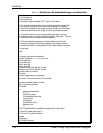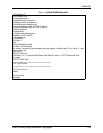
PostScript
1-38 Guide to Using Page Description Languages
The following example shows the choice of row or column to
describe an arbitrary one-dimensional slice of an image that
depends on the viewpoint.
Regardless of which scan order is chosen, the scan proceeds in
one direction (called the fast scan direction) through each
parallel slice in turn, progressing through the slices in a direction
called the slow scan direction.
In sequence A, the fast scan direction is left to right and the slow
scan direction is top to bottom. For sequence B, the fast scan
direction is bottom to top, and the slow scan direction is right to
left. The terms left, right, bottom, and top only have meaning
based on the orientation of the image on the page.
When DocuPrint NPS/IPS executes a PostScript program, the
principal product for each page is an image just like the images
that can be incorporated into PostScript programs. The image
data is transferred to the imaging hardware as a sequence of
values in laser scan order.
Considerations
The scan order of an image relative to the content of the image is
not important. It is important that the scan order of the image in
the desired orientation is relative to the scan order of the page.
Table 1. Image pixel sequence example
Image:
00000000
00011000
00111100
01111110
00011000
00000000
Sequence A (origin top left, row scan order):
0 0 0 0 0 0 0 0 0 0 0 1 1 0 0 0 0 0 1 1 1 1 0 0 0 1 1 1 1 1 1 0 0 0 0 1 1 0 0 0 0 0
0 0 0 0 0 0
Sequence B (origin bottom right, column scan order):
0 0 0 0 0 0 0 0 1 0 0 0 0 0 1 1 0 0 0 1 1 1 1 0 0 1 1 1 1 0 0 0 1 1 0 0 0 0 1 0 0 0
0 0 0 0 0 0


















